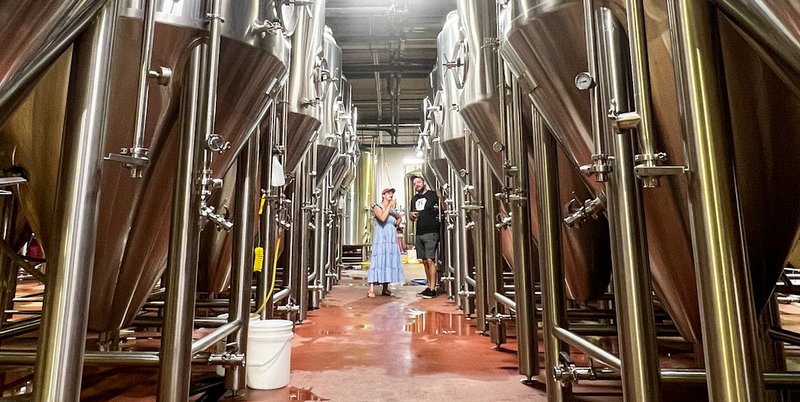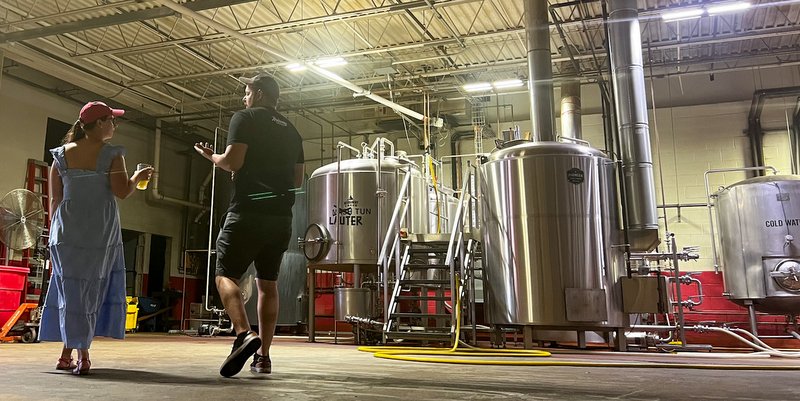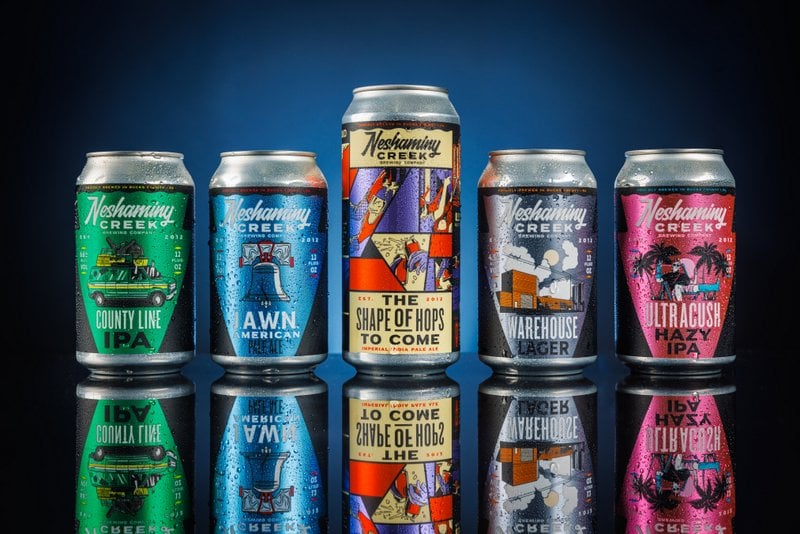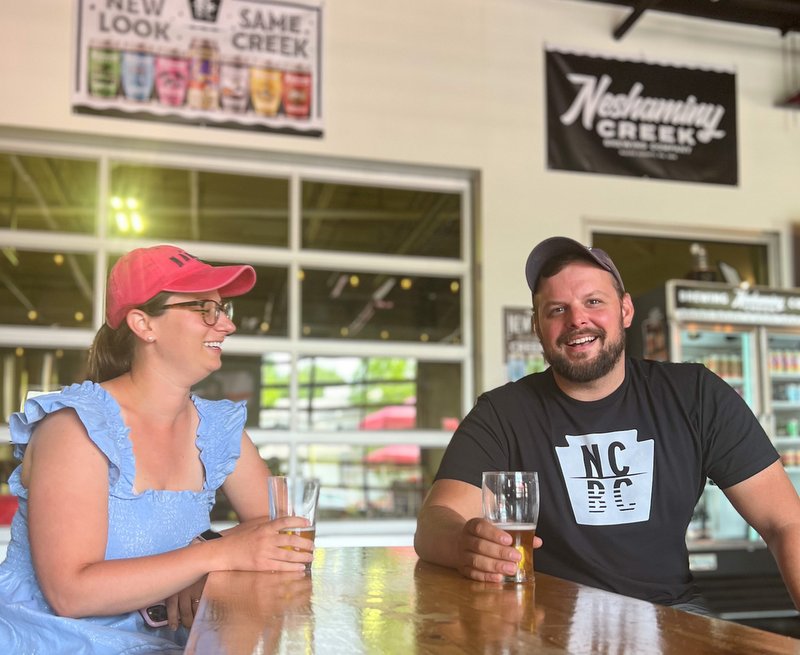
Neshaminy Creek Brewing Company wouldn’t have survived the pandemic continuing with the status quo. Heck, the Pennsylvania brewery was on the brink of bankruptcy prior to the pandemic.
“Quickly I realized ‘wow,’ I had no idea what I was getting into,” says Jenna Ball, now the CEO of Neshaminy Creek, on assessing the situation at Neshaminy Creek when she started as CFO in June 2019. “These guys are like real close to bankruptcy, right there teetering on the edge, and we’ve got a lot to figure out to just live to fight another day.”
Neshaminy Creek is a production brewery, but not of a ridiculous size, with a 15-bbl brewhouse, producing 10,000 bbls annually. They have the ability to scale down or up fairly quickly depending on the situation.
When Rob Jahn was 25, he was one of three co-founders of the brewery. As lead brewer and production manager, he wasn’t always in tune with the day-to-day financials, which were starting to get out of hand. Decisions were made with the goal of growing Neshaminy Creek to a 70,000 bbl brewery, and to look a certain way to the public.
“The vision for the brewery in the past was ‘grow, grow, grow, expand, expand, expand’ in any way possible regardless of whether it’s the right move at the time. We were selling a tremendous amount of beer and growing, but we took the hit on the economic side of the business with the hopes of growth,” Jahn said.
This is an easy trap for a production brewery to fall into, one started in a different era, chasing ridiculous growth goals as the way to make the margins work.
Speaking with Jahn and Ball over Google Meet, it is obvious Jahn and the brewery are in different places than when they started.
“The learning curve over the last 12 years has been incredible,” Jahn says. “There was a business plan, with the laws that were in place, with the competitive landscape being what it was at the time … things have shifted, and we need to shift along with it. A lot of decisions were made with that growth trajectory that was no longer realistic with the amount of competition that entered the market.”
Neshaminy Creek has since righted the ship. Here’s how they did it.
Chasing growth ‘the wrong way’
Here’s two examples of chasing growth the wrong way:
1. Going wide instead of deep: To expand into as many territories as possible, Neshaminy carried a lot of salespeople on staff in Pennsylvania, Maryland, Delaware, and New Jersey – 13 in total – none of which was self-distribution.
“We were paying someone to build up those territories, to make sure we’re hitting the CE rate, but by that point, at year five until year eight, the number of breweries that were opening up in those territories and in all of America, the ability for a smaller production brewery, for us, to get to that size, it just wasn’t a realistic goal. Since then we calibrated and our sales team works closely with our distribution partners,” Jahn said.
2. Marketing by emotion and not ROI: In terms of marketing, well, come to find out, in 2020, they spent “$60,000 on a freaking billboard,” as Jahn put it.
“We learned that there are times when you want to go big, but what you really need is to stop and do a gut check on whether or not it will create the direct impact you want. We now know that being more targeted with things like t-shirts and logo hats for key accounts will go further and build loyalty. We could have spent the money smarter to help us grow.”
Thirty years ago, a billboard might have been a great way for an up-and-coming smaller operation in a less crowded field to achieve these goals and stand out. In 2020, in the world of social media and roughly 9,000 craft breweries? Unless your brewery is printing money, that billboard is marketing misconduct.
New leadership, new vision

“I’ve spent a great deal of time reflecting on how Neshaminy Creek got here,” Ball says, asking just as I did: “How did we get in this perilous position when we were selling such a volume of beer?”
Ball doesn’t come from a brewing background, working previously as a controller for a medical device and tech company in Baltimore. After she and her family relocated to Bucks County, and after she was ready to emerge from maternity leave, a recruiter pointed her to a CFO opportunity at Neshaminy Creek.
Right away Jahn wanted to hire Ball, but the feeling wasn’t instantly mutual.
“I wasn’t sure if I was going to be a great fit. The branding at the time just didn’t necessarily feel like it resonated with me. But in my interview, I asked Rob ‘which breweries do you really admire and that you’d like to emulate?’ and he mentioned Allagash. I thought, if that’s what you’re looking to build, I want to build that too.”
Almost immediately Ball was moved from that original CFO position to CEO.
“She really organized this chaos in a relatively quick fashion,” Jahn says, immediately setting into motion:
- A culture change
- A coordinated effort on social media
- A quality rebrand
- Securing relationships with wholesalers
- Keeping prices stable
What a ‘culture change’ looks like
While the billboard was out there, marketing for broad mass appeal, back at the brewery, the workplace was clearly meant for just one group.
“I’m coming into this workspace, and this is an intimate and fun brewery environment, but it’s still a business, and there’s inappropriate drawings everywhere and posters and, yeah, I’m not loving that,” Ball explains.
There was no major scandal of inappropriate behavior to report, but just that ever-present, often oppressive boy’s club culture that exists at way too many craft breweries and pretty much any male-dominated industry.
“We needed serious changes, and we made those, and we’re continuing to make changes as we go along because not only is it better in line with personal values that Rob and I and our management team might hold, but it’s also just a better, more inclusive business. Because let’s be honest, the goal is to sell more beer. And you do that by creating a wider more diverse audience that feels welcomed and wants to be a part of what we are doing,” Ball explains.
“If Jenna didn’t see that we had the willingness to evolve as a company, she wouldn’t be around,” Jahn admits.
And listening to employees and the management team is a big part of this culture shift. In the past, everything only went through leadership who made the final decisions and missteps. Then, their missteps multiply and compound over time.
[Our staff] “are good at what they do, and if they have a perspective on something that I personally don’t deal with every day, whether it’s supply chains or something from a branding perspective, we all collaborate and try and get each other’s viewpoints,” Jahn says.
Shift in growth strategy
Neshaminy Creek will still be a production brewery, but the aspirational growth plans are more in line with industry reality in 2022: “We are at a point where we are ready to grow and we absolutely want to expand our number of taprooms. I’d love to see us open several more tap rooms,” Ball says.
Taproom revenue is about 45 percent of the overall business. But of course, margin-wise, the taprooms are “quite nice, yeah,” as Ball says. Only 10 to 11 percent of overall production goes to the taprooms, so there is plenty of capacity to continue growing in taprooms. “We’re in this unique in-between space where we were built out initially for mass production, but then we incorporated the local taproom element, and I think we’re actually positioned to have quite an advantage because we can supply so many taprooms with what we can produce,” Ball says.
On the sales side, they have scaled back to three reps, one in Philadelphia and two in New Jersey (although director of sales and marketing Kyle Park and Jahn will pop out to accounts occasionally).
“Having a presence in our home markets is essential. Distributors have so many other brands that they’re representing as well,” Jahn says. “You’ve got to be an ambassador with your own distributors to get airtime because they all have a million things to do. Why are they going to have our name be the first one out of their mouth if they’ve got someone’s ear?”
It comes down to being an asset to the distributor representatives. Another great way to refresh that relationship is with a rebrand of your own.
Rebranding decisions and shelf appeal

The money spent on advertising is way more coordinated nowadays than it was in the past. With a new management team and philosophy came new branding.
“We had really cool artwork, but that doesn’t always translate to a good marketing effect on the shelf,” Rob says. “We kind of wanted a transition from the old cartoon-style artwork to a more graphic novel, mature approach. It wasn’t too much of a departure, just a more grown-up version.”
This gets back to the idea of inclusivity – gathering more opinions and involving more people in decision-making. This includes distributors, Ball notes:
“If you just have your own tunnel vision, you can create something really cool and beautiful, but you also want everybody that needs and relies on that artwork to also have eyes on it,” she says. “If they say, ‘hey if you position it that way, I’m not going to know how to orient the can on the shelf.’ So, we really went through a painstaking process and took a ton of feedback, loads of revisions and I’m just wildly proud of what we have put together.”
The Neshaminy Creek rebrand is only six months old, but sales of its core brands are growing.
“It’s working. Our numbers are definitely up,” Jahn says.
Party time

Set the 12-year story arc of Pennsylvania’s Neshaminy Creek — from inception to opening to rebrand — to the tune of a fun, fast-paced jam from the 2010s, and you essentially have a montage of the evolution of the craft beer business model and industry culture the past decade.
With the montage behind Neshaminy Creek, it was time for a party and a freeze-frame high-five. Neshaminy’s anniversary bash fit the bill and then some, which caught our eye and ear for its impressive guest list and fun activities.
“We have to constantly evolve and change and mature,” Jahn says, summing up each and every change the brewery has undergone – from financial to branding – as an overall maturation process. “We’re still dealing with ramifications of the past, but with the evolution of what we’ve done in the last three years, it might as well be a completely different brewery.”






Neshaminy Creek Brewing Co says
Great time chatting with ya!